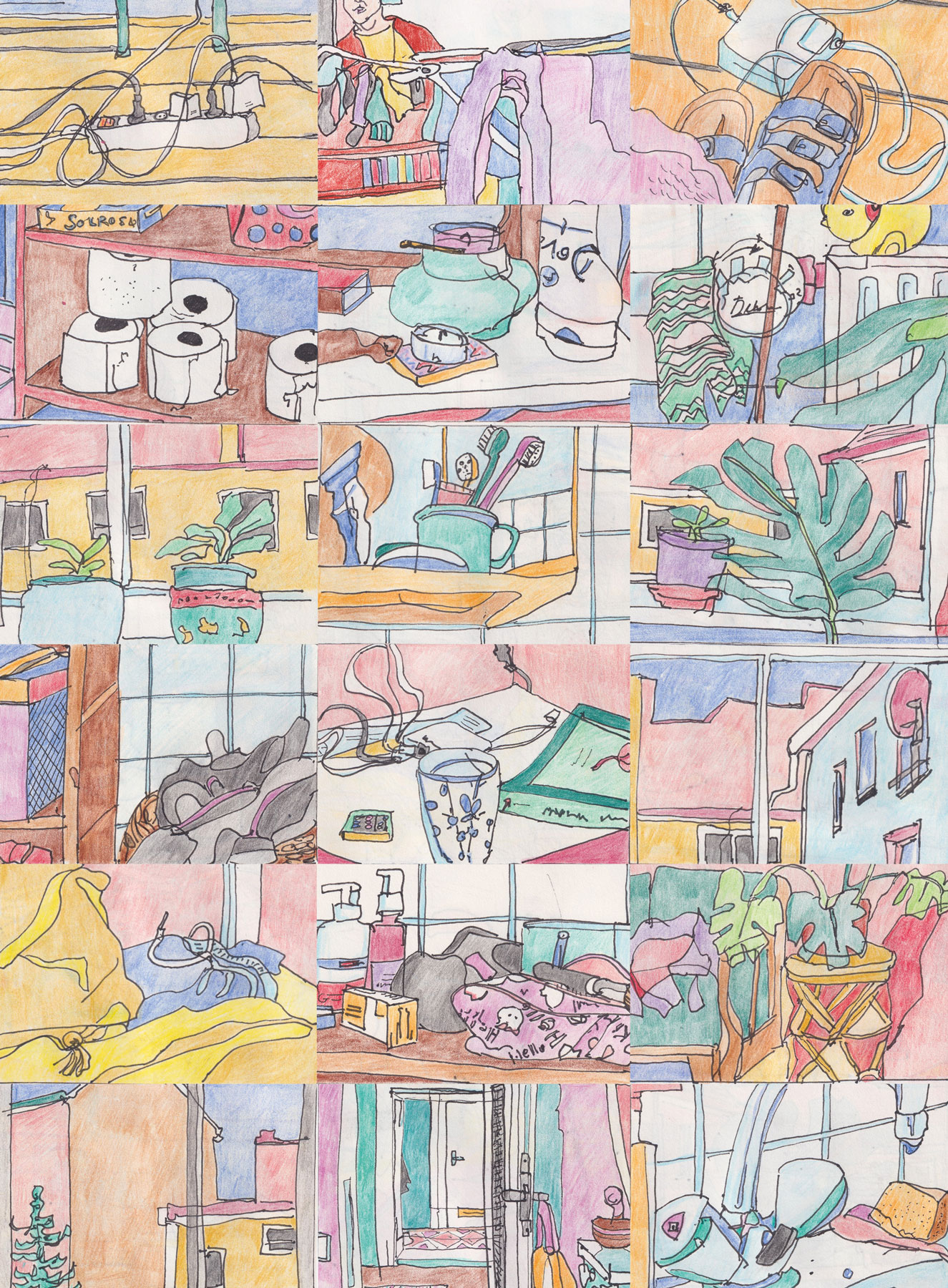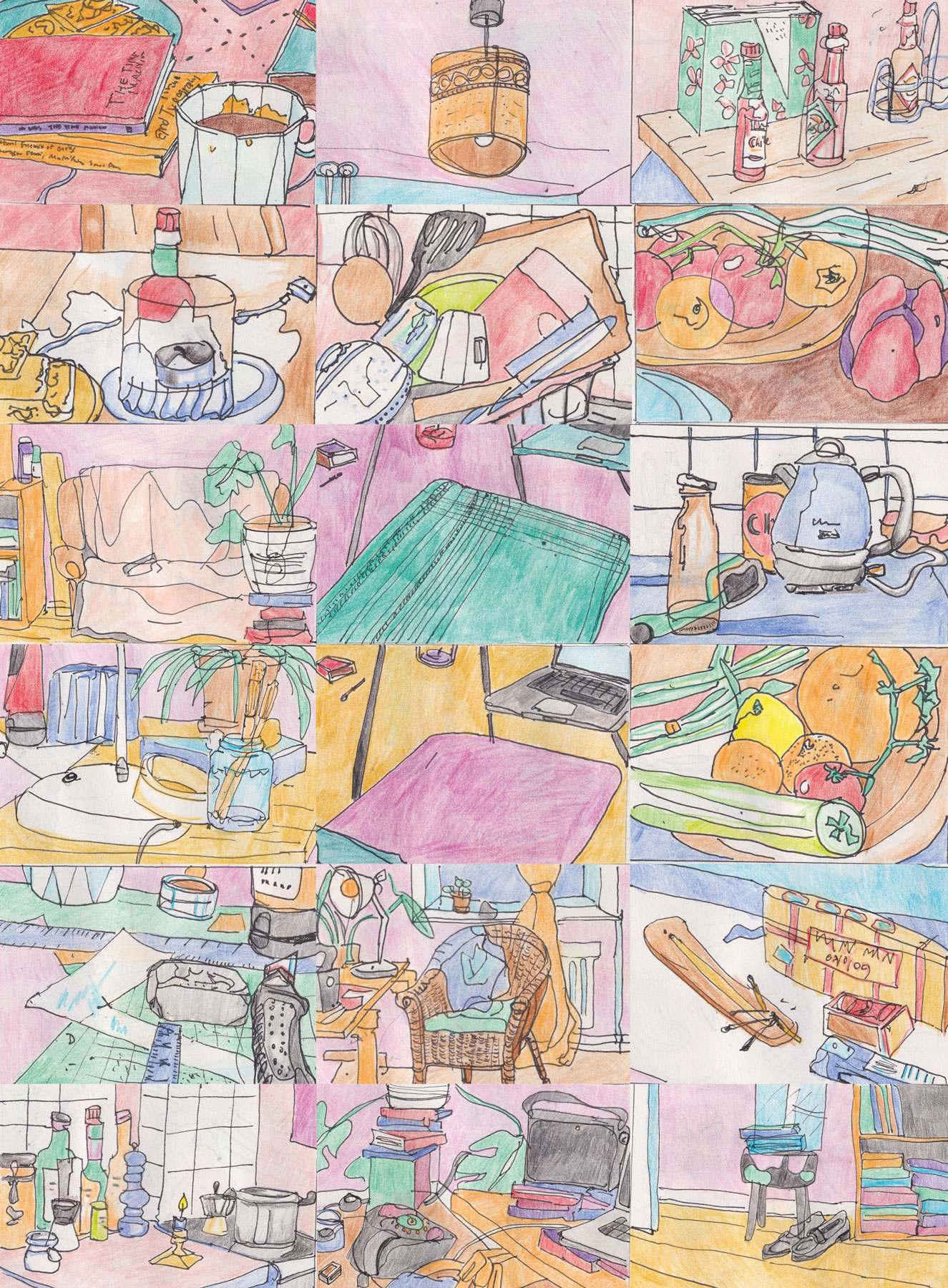Window views
Colored pencil, finelinerEach illustration 12 x 8 cm
2020
About observing and drawing one’s apartment from every possible angle; Window views is essentially about experiencing a view seen a million times before, in a wholly new way. The collection of snapshots picturing everyday motives, was created during the Corona-pandemic for a special issue of Sponge magazine. The illustrations are quick sketches with fineliner, that were colorized later on.


Window views are accompanied by the following text that was published in Sponge Magazine’s special pandemic issue from 2021. The drawings also appeared as a zinefold attached in the back of the magazine. Click here to see more.
Window views represents for me the experience of seeing a view seen a million times before, differently; I moved apartment in the middle of the pandemic, and when looking out of the old window for a last time,
I realized that for two years I had only been looking in one direction. It was only because of my habitual way of doing it, that I missed the other side of the backyard.
During this year we have had to turn to the sphere of our homes and families, but this time it was not a choice but an obligation, which is something that most of us have never experienced before. In one way, our lives were striped down to nothing more than our everyday lives or routines. Or at least there was a chance to review, change and contemplate them during months of lockdown.
What is referred to, when writing ”everyday life”? To put it short, for me those are the familiar activities that we repeat on a daily basis. One could also talk about habits, but I think a habit is more particular. Everyday life is a fluid and abstract description that include further patterns, places and events.
According to Guy Debord in his text ”Perspectives for Alterations in Everyday Life” from 1961, Henri Lefebvre defines everyday life as ”whatever remains after one has removed all specialized activities”. 1
I realized that for two years I had only been looking in one direction. It was only because of my habitual way of doing it, that I missed the other side of the backyard.
During this year we have had to turn to the sphere of our homes and families, but this time it was not a choice but an obligation, which is something that most of us have never experienced before. In one way, our lives were striped down to nothing more than our everyday lives or routines. Or at least there was a chance to review, change and contemplate them during months of lockdown.
What is referred to, when writing ”everyday life”? To put it short, for me those are the familiar activities that we repeat on a daily basis. One could also talk about habits, but I think a habit is more particular. Everyday life is a fluid and abstract description that include further patterns, places and events.
According to Guy Debord in his text ”Perspectives for Alterations in Everyday Life” from 1961, Henri Lefebvre defines everyday life as ”whatever remains after one has removed all specialized activities”. 1
The definition seems, to me, wanting to put the everyday in a negative light because it takes out all the fun and eventful things of life. But perhaps it sums up exactly what happened during lock-down. That is to have nothing special to look forward to: No weekend, no trips, no dates, no parties, no restaurants, no sport, no concerts, not even such a simple thing as going out for a coffee.
It seems like there is a tendency to think about everyday life as something unimportant or boring. Or like a natural instinct of constantly wanting to escape it. That means there is a kind of resistance or disagreement within the concept, because the truth is that we can never get away from the everyday. It is only a matter of accepting it. Debord mentions in his text that the everyday is the center and the measure of everything, that ”every project begins from it and every realization returns to it to acquire its real significance.”2
I think that during months of lock-down, it has become quite clear that everyday life and routines are fundamental. Because it was especially the mundane things, like daily walks when finishing home-office or doing yoga in the morning with my room mate, that saved me. I started to appreciate the small things, because there was nothing else. Was the quarantine neccesary to make peace with the everyday life?
It seems like there is a tendency to think about everyday life as something unimportant or boring. Or like a natural instinct of constantly wanting to escape it. That means there is a kind of resistance or disagreement within the concept, because the truth is that we can never get away from the everyday. It is only a matter of accepting it. Debord mentions in his text that the everyday is the center and the measure of everything, that ”every project begins from it and every realization returns to it to acquire its real significance.”2
I think that during months of lock-down, it has become quite clear that everyday life and routines are fundamental. Because it was especially the mundane things, like daily walks when finishing home-office or doing yoga in the morning with my room mate, that saved me. I started to appreciate the small things, because there was nothing else. Was the quarantine neccesary to make peace with the everyday life?
1 Guy Debord, ”Perspectives for Alterations in Everyday Life”, from The Everyday Life Reader, ed. Ben Highmore, (New York & Oxon: Routledge, 2002), s. 239. 2 Ibid.
